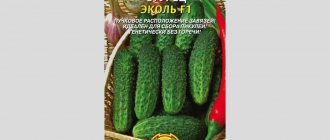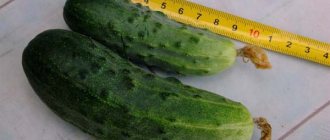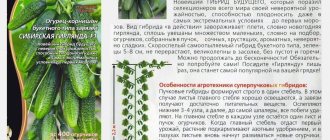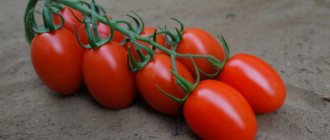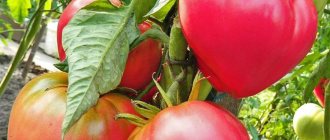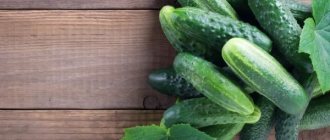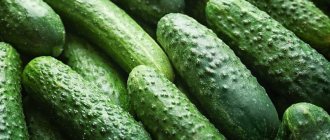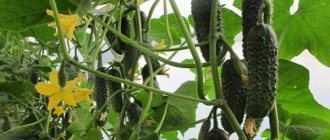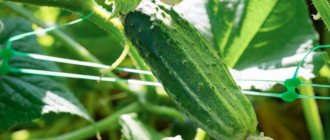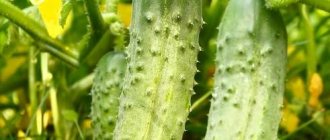Breeding history
The Siberian garland is the brainchild of South Ural breeders. The idea of obtaining a bunch variety of cucumbers that can be grown in harsh climates appeared a long time ago, but attempts for a long time did not lead to the desired result. Fortunately, at the Chelyabinsk breeding station in 2013, this case was crowned with success. After this, the hybrid quickly spread, since the demand for it appeared long before its appearance.
The cucumber received excellent evaluations from experts; its agrotechnical characteristics and taste properties were excellent. The name was given because many fruits develop on one bunch.
Related article:
Why crooked cucumbers grow: possible reasons, solutions to the problem and recommendations
Description
The hybrid is included in the premium segment and belongs to the bunch group of cucumber varieties. This means that in place of one bud, several ovaries are eventually formed. At the same time, the plant has enough potential for all these fruits to grow and develop normally.
Siberian garland is ideal for unstable climatic conditions; the hybrid is hardy and resistant to both droughts and rainy periods. This allows it to be successfully cultivated in almost all regions, except for the Arctic and subarctic zones.
Main characteristics
The hybrid embodies all the most modern requirements for crops of this group: it can quickly adapt to weather conditions, does not require insects or special conditions for pollination, and ripens quickly. After sowing, the first harvest begins to be harvested within 1.5 months.
Siberian Garland is a first generation hybrid, as evidenced by the designation F1 on the packaging. This means that it will not be possible to obtain seed material with all the characteristics after collecting seeds from a grown fruit: they appear only in purchased planting material.
With normal care, tall vines grow, but in order for them to be powerful, the bush must be shaped.
A distinctive feature is also that the internodes are quite short. This allows you to get more yield even with moderate growth.
The variety is classified as super-yielding, since 12-14 full-fledged fruits can ripen in one ovary. Moreover, they are always of the correct shape; changes are extremely rare. The peel is thin, it becomes thick only when harvested late. There are no pronounced bumps on it: there is a small edge, but it is very gentle, not prickly.
Related article:
I plant cucumbers using the method of a Belarusian aunt
The taste characteristics deserve special attention. The flesh is crispy, juicy and dense. Bitterness and unpleasant wateriness cannot form. The absence of voids is also guaranteed even when overripe or underwatered. Zelentsy are slightly smaller than the average size - 6-8 cm. They do not outgrow, but simply stop growing when ripe.
The growth rate of fruits is moderate, which makes it possible to collect them at the stage of technical maturity, even with relatively infrequent harvesting. True, with this approach the tying of new buds and greens slows down.
The fruiting period is very long, it lasts almost until frost.
A decrease in average daily temperatures makes growth and maturation slower, but does not stop it completely.
Features of cultivation
The bush must be formed according to the scheme presented below in 1 stem. It is necessary to tie the stem to a support and remove the side shoots at the bottom 50 cm up from the ground. Leave one ovary and one leaf in each axil. In the middle part of the vine, 2 ovaries and 2 leaves are already left. When the height of the trellis is reached, the end is pinched and the bush is allowed to grow horizontally.
Siberian Garland F1 is a tasty, super-yielding hybrid with a long fruiting period. To grow it, additional time, effort, and information about specific agricultural techniques that will ensure maximum fruit production for a long time are required. That's why
You may be interested in: Secrets of growing cucumbers in a barrel
See also: How to tie cucumbers in open ground
Productivity
The main pride of the creators of the Siberian garland is its colossal productivity. In one season, you can collect 400-500 greens from a plant. This is approximately 20-25 kg. But amateur gardeners need to remember that such indicators are only possible under ideal conditions and well-thought-out agricultural technology, taking into account all the needs of the crop.
Related article:
Everything you need to know about cucumber crops
However, a harvest of 15-17 kg is quite possible in an ordinary garden or dacha if you approach the issue responsibly.
Area of application of fruits
Siberian garland produces greenery of a universal type. They are ideal for fresh consumption or for salads. It is very good to use them for marinades and pickles, in which they retain their crispy structure. The small size makes the fruit an excellent material for canning.
Zelentsy is stored perfectly in the refrigerator: without loss of quality in the vegetable compartment, the storage time is approaching a month. Cucumbers grow evenly shaped and of the same size, and this makes them attractive in the eyes of buyers. The fact that they are transported without loss of external characteristics helps to easily deliver them to the point of sale and quickly sell them. If we add to this the high yield, it becomes obvious that the hybrid is very attractive from a commercial point of view.
Related article:
The most important thing about the problems of cucumbers
Diseases and pests
The hybrid is resistant to the most common fungal diseases of cucumbers. It is rarely affected by brown spot and powdery mildew. Cucumber mosaic virus is also rare when growing this crop.
Experts say that during cultivation you may encounter the following diseases:
- downy mildew - with systematic ingress of water drops during watering;
- white rot - during rainy periods;
- root rot - due to watering with cold water;
- gray rot - when planting in a place where other melons previously grew;
- anthracnose - when plantings are too thick.
Most diseases are not dangerous for this cucumber hybrid if you follow basic care recommendations.
Among the pests it can be affected by root-knot nematode, sprout fly and melon aphid. Treatment with special preparations helps. Slug attacks are also possible. Preventive measures are considered the most effective against them: systematic removal of weeds and harvesting of any fruits after ripening. When an area becomes infected, chemicals help.
Important! How to deal with aphids on cucumbers
Good varieties, according to reviews from gardeners
When choosing a variety of cucumbers to plant in your summer cottage, you must also be guided by reviews from gardeners. They can recommend the best option from their experience.
Parisian gherkin
Miniature cucumbers, called gherkins, have always attracted gardeners with their distinctive qualities. This variety is characterized by a rarely encountered sweet and sour taste and is not demanding in content.
Main characteristics:
- The variety is early ripening, the greens ripen 40 days after the seedlings emerge.
- The fruits are miniature, oblong-oval. The maximum weight of a cucumber is 85 g. The peel is a bright pistachio color with white stripes along the entire length. There are brown spines on the surface, arranged in a chaotic manner. The length of the fruit barely reaches 11.5 cm.
- Medium climbing shrub. The leaves have a gray-green tint and are quite large in size.
- Diseases. The vegetable crop has strong immunity to almost all viral and infectious diseases.
- Productivity is low, no more than 6.5 kg per 1 sq. m. However, the plant is capable of bearing fruit throughout the growing season. Pollination by bees.
- The purpose is universal.
Enthusiasm
Due to the miniature size of the fruits, the variety is classified as gherkins. The self-pollinating, high-yielding hybrid is loved by a huge number of gardeners.
Main characteristics:
- The variety is early ripening, the greens ripen on the 42nd day.
- The fruits are 9 cm in size. The peel is loose, bright olive in color, with a small number of light stripes. Greens are characterized by juiciness, crunchiness and watery pulp. The weight of the cucumber barely reaches 87 g.
- Medium climbing shrub. The leaves are medium-sized, wrinkled with a wavy edge. A leaf node forms no more than 4 ovaries. There are no barren flowers.
- Diseases. The plant has excellent immunity to viral and infectious diseases.
- Productivity is high, from 1 sq. m yields about 13 kg of cucumbers.
- The purpose is universal.
Miranda F1
It was released in 1992 in the Moscow region. The main advantage of this variety is the ability to grow indoors. Thanks to this quality, cucumbers can be grown even in the northernmost region of our country.
Main characteristics:
- The variety is early ripening, the greens ripen already on the 46th day.
- The fruits are oval, with barely pronounced tubercles. The weight of a cucumber can vary from 80 to 115 g. The maximum length is 13 cm, with a diameter of 4.5 cm. The peel is dense, dark olive in color with a small number of whitish stripes. The pulp is characterized by crunchiness and aroma.
- The shrub is vigorous, weakly branched. Smooth, small leaves of a rich green hue. The leaf node forms about 3 ovaries.
- Diseases. The plant has excellent immunity to many common cucumber diseases. Preventive measures are acceptable, but not required.
- Productivity is low, from 1 sq. m comes out to no more than 6.5 kg.
- The purpose is universal.
Advantages and disadvantages
To choose a given hybrid, you need to compare all its strengths and weaknesses. The benefits of this cucumber are:
- excellent taste;
- precociousness;
- high productivity;
- long fruiting;
- parthenocarpicity - no need for insects for pollination;
- high adaptability to different weather conditions;
- resistance to specific diseases.
Related article:
Growing strong cucumber seedlings
Along with this, there are the following disadvantages:
- high cost of seeds, which is beneficial mainly for commercial cultivation;
- demanding in terms of care and mandatory compliance with agricultural technology rules;
- the need for frequent harvesting for the appearance of new ovaries throughout the entire fruiting period.
We can conclude that for summer residents who rarely visit the garden, or for those who do not intend to spend a lot of time in the garden beds, this hybrid will not be the best solution. But the rest will get the maximum result with the same effort expended.
Cucumber Siberian Garland F1: reviews from those who planted
Many gardeners have already tried to grow such a wonderful super-bunched and productive hybrid of Siberian Garland cucumbers on their plots - reviews are given below.
Elena, 45 years old, Krasnoyarsk Territory: We planted this variety of cucumbers for the first time last year, read about it on the Internet with my husband and decided to try to grow a super-bunch hybrid in our greenhouse. We bought one bag of seeds (there were 5 of them). We grew it in seedlings, and everything sprouted! At the age of approximately 30 days, the seedlings were transplanted into a greenhouse. The beds were fertilized with humus in advance and dug up. During cultivation, watering was regularly carried out, fertilizers were applied, and the bushes were formed strictly into one stem. As a result, from each bush of the Siberian garland we received 30 kilograms of exactly ripe products. Moreover, the first harvest was harvested already in the second ten days of June. There were enough gherkins for food, for twists, and part of the harvest was successfully sold. We will continue to grow this variety in the future.
Polina, 53 years old, Republic of Bashkiria: We installed a large polycarbonate greenhouse on the plot and now we regularly grow vegetables for sale. Accordingly, for planting, we choose varieties and hybrids that do not require pollination, so as not to bother with pollinating plants for good yield, because there is tension with the bees now. Part of the beds in the greenhouse is reserved for cucumbers, and we try to grow early-ripening varieties with high yields. Last year, the Siberian Garland variety was planted for the first time. The plants grew well in greenhouse conditions, the bushes were formed into one stem, tied to trellises, fed and watered, as written in the description. As a result, the fruits on the vines of these cucumbers actually hung like garlands. But I noticed that the more often they harvested, the faster new gherkins formed on the Siberian Garland variety. The collected greens are tasty, aromatic, smooth and crispy. All the customers were delighted with these gherkins. We will continue to grow.
The Siberian Garland cucumber, according to the description of the originators of the variety, is an early superbunch hybrid of the gherkin type with high yield, resistance to stressful situations, resistance to disease, and good taste of ripe fruits.
It can be grown in garden beds and in protected ground, as well as on glazed balconies, since the variety does not require pollination. Thanks to these advantages, the variety quickly became popular among Russian vegetable growers from different regions.
Planting and care
Successful cultivation of this cucumber requires knowledge of its agricultural technology. Beginners should not be afraid, just learn all the features of care and gradually implement them.
Seed preparation
Before sowing, you need to separate viable seeds from empty ones. To do this, dilute 50 g of salt per 1 liter of water and pour the planting material into this solution. Those seeds that float should be thrown away: they are empty.
Related article:
What harms cucumbers
Next, disinfection is carried out: take 1 liter of water, a spoonful of ash and a spoonful of Nitrophoska and keep the seeds in this solution for 12 hours. It is advisable to do this in a warm place.
Sowing
Sowing is carried out in the second half of March or at the very beginning of April. There is no point in doing this before, since the duration of daylight hours is not enough for the normal development of the sprouts, moreover, they will suffer if they are not planted in a permanent place at the right stage of growth.
The substrate needs to be nutritious, but loose. Planting is carried out to a depth of about 1.5 cm in small cups. After this, they are covered with transparent cling film and placed in a place with a temperature of about 25°C. In this case, direct rays of the sun should not fall on the container. It is necessary to constantly maintain an optimal level of humidity inside such an improvised greenhouse. Typically, spraying is carried out every three days, and the droplets collected on the film are removed.
As soon as the first seedlings sprout, they gradually begin to accustom them to normal air humidity. To do this, the film is removed daily, increasing the ventilation time.
Related article:
Kotor f1 - a cucumber variety with high yield
Hardening off seedlings
1-1.5 weeks before transplanting to a permanent place, the seedlings begin to harden. This process involves taking the young plants outdoors and leaving them exposed for 60 minutes. Every day the time is increased by half an hour.
At the last stages of hardening, the cucumbers are left to spend the night outside. Of course, the forecast should not promise sudden cold snaps or heavy rains.
Landing
In warm regions, planting begins in May. Experts say that it is more correct to focus on the soil temperature: it should be about 15°C.
The soil is prepared in advance, in the fall. A lot of organic matter is added to it, which will help the hybrid realize its full potential. When planting, place 1 tbsp in each hole. l. urea and a handful of wood ash.
The planting pattern is important: each plant is located half a meter from the neighboring one. It is this distance that will allow the root system to develop normally and grow a large number of cucumbers.
Dense planting will dramatically reduce yields and increase the likelihood of fungal diseases.
Watering is carried out twice: before planting seedlings and after they are placed in holes and dug in. Young plants should be immersed in the ground so that the lower leaves are immediately above the ground level after watering.
Related article:
How to get cucumbers to bear fruit before frost
Seedless method
Seedlings are transferred to open ground later, most often in early June. They are placed not so far from each other: 7-9 cm between rows and 20 cm from plant to plant in the same row is enough. The seeds need to be buried to a depth of approximately 5 cm. The germination rate is much lower than when growing seedlings. You need to be prepared for the fact that other seedlings will have to be replanted in those places where the seeds have not sprouted.
Shaping bushes
When growing this hybrid, be sure to use trellises. Posts 2 m high are placed between the rows at different ends. A wire is stretched across them, and it is advisable to attach a coarse mesh to it. The optimal cell size is 20 cm. The first lashes are attached to it in the desired direction, and the rest, as a rule, are attached themselves. In a greenhouse, fixation is carried out only on one side, and when growing this type of cucumbers in open ground, on both sides.
The formation of a bush is crucial in the greenhouse method and in the middle zone.
In the southern regions, even without shaping, each cucumber will have enough sun to ripen. For the remaining bushes, you need to constantly maintain the shape of one main stem, on which the ovaries will form. After the main vine-like shoot grows to the top of the trellis, it is wrapped around the support and the top is cut off.
Related article:
The most important thing about the problems of cucumbers
Feeding
It is important to fertilize throughout the growing season. Once a week, fertilize with complex organomineral compounds. This must be done on moist soil.
Watering
It is best to water at the root. Drip irrigation is ideal for this hybrid: this reduces the likelihood of developing infectious diseases. To prevent sunburn on the leaves, it is best to moisturize in the morning or evening. The hybrid is able to withstand a dry period, but the yield will decrease, but it will be restored immediately after the irrigation regime is restored.
Experts recommend moistening the soil every 2-4 days. The frequency depends on the air temperature.
The most productive varieties for Siberia
To get a good harvest of cucumbers, you need to choose the right variety. You will find out which one is suitable for Siberia further.
Claudia
The advantage of this variety is its good immunity to low temperatures.
Main characteristics:
- The variety is mid-season, fruiting occurs on the 54th day from the moment of the first shoots.
- The fruits have an ellipsoidal shape, the length does not exceed 11 cm. The maximum weight of a cucumber is 95 g. The peel is tuberous with a barely noticeable fluff. The pulp is crispy and has a sweet aftertaste.
- A tall shrub with looping shoots, suitable for keeping in a greenhouse. Strong roots and well developed main stem. The leaves are not large, greenish in color. There are no barren flowers.
- Diseases. The plant is not afraid of viruses and infections. But sensitive to the sun, high risk of sunburn.
- Productivity is stable, up to 27 kg per 1 sq. m.
- Purpose: canning.
Brigantine F1
This variety responds well to mineral-based fertilizers and timely watering with warm, settled water. With proper care, the bushes bear fruit well and do not get sick.
Main characteristics:
- The variety is early ripening.
- The fruits are ellipsoidal, rich olive in color with massive tubercles on the skin. The maximum length of a cucumber is 14 cm, the minimum is 9 cm. The diameter of the fruit is at least 3.5 cm.
- Small shrub. The length of the main stem is up to 90 cm. The leaves are not large with a rounded edge. Ovary length – 5 cm.
- Diseases. The plant is practically not susceptible to viruses and infections.
- Productivity. Pollination by bees. Capable of producing up to 34 kg of harvest per 1 sq. m.
- Purpose: canning, salting.
Alliance
It has 2 varieties from different manufacturers. The first was invented by a Russian breeder from Rostov-on-Don and is used in areas with cold climates. The second is produced by a Dutch company and is a hybrid variety.
Main characteristics:
- The variety is early ripening, fruiting occurs on the 56th day (and is repeated several times during the season).
- The fruits are tubular with a strong skin. The surface is ribbed, bright pistachio in color with barely noticeable stripes. The shape of the cucumber is slightly elongated. The maximum size of the fruit is 19 cm. The weight of the cucumber does not exceed 120 g.
- The shrub is spreading, with high branching. The leaves are voluminous with a wavy edge, of a dull greenish tint. From 2 to 4 ovaries develop on one stem.
- Diseases. The plant has good resistance to various types of diseases.
- The yield, with proper care, is at least 18 kg per 1 sq. m.
- The purpose is universal.
Emelya
In 2003, the variety was included in the state register of the Russian Federation, and subsequently gained enormous popularity among a large number of gardeners.
Main characteristics:
- The variety is early ripening, the greens ripen 44 days after the appearance of the first seedlings.
- The fruits have an oblong oval shape. Massive tubercles are randomly located on the peel. The weight of the greens is no more than 140 g. The maximum size is 16 cm with a diameter of 4.5 cm.
- The shrub is vigorous, shortened, bunched. The foliage has a bright green color and a wavy shape.
- Diseases. Due to its developed cold resistance, the vegetable crop has strong immunity. Therefore, he gets sick extremely rarely.
- Productivity. Bees are not required for pollination. From 1 sq. m comes out to more than 16 kg.
- The purpose is universal.
